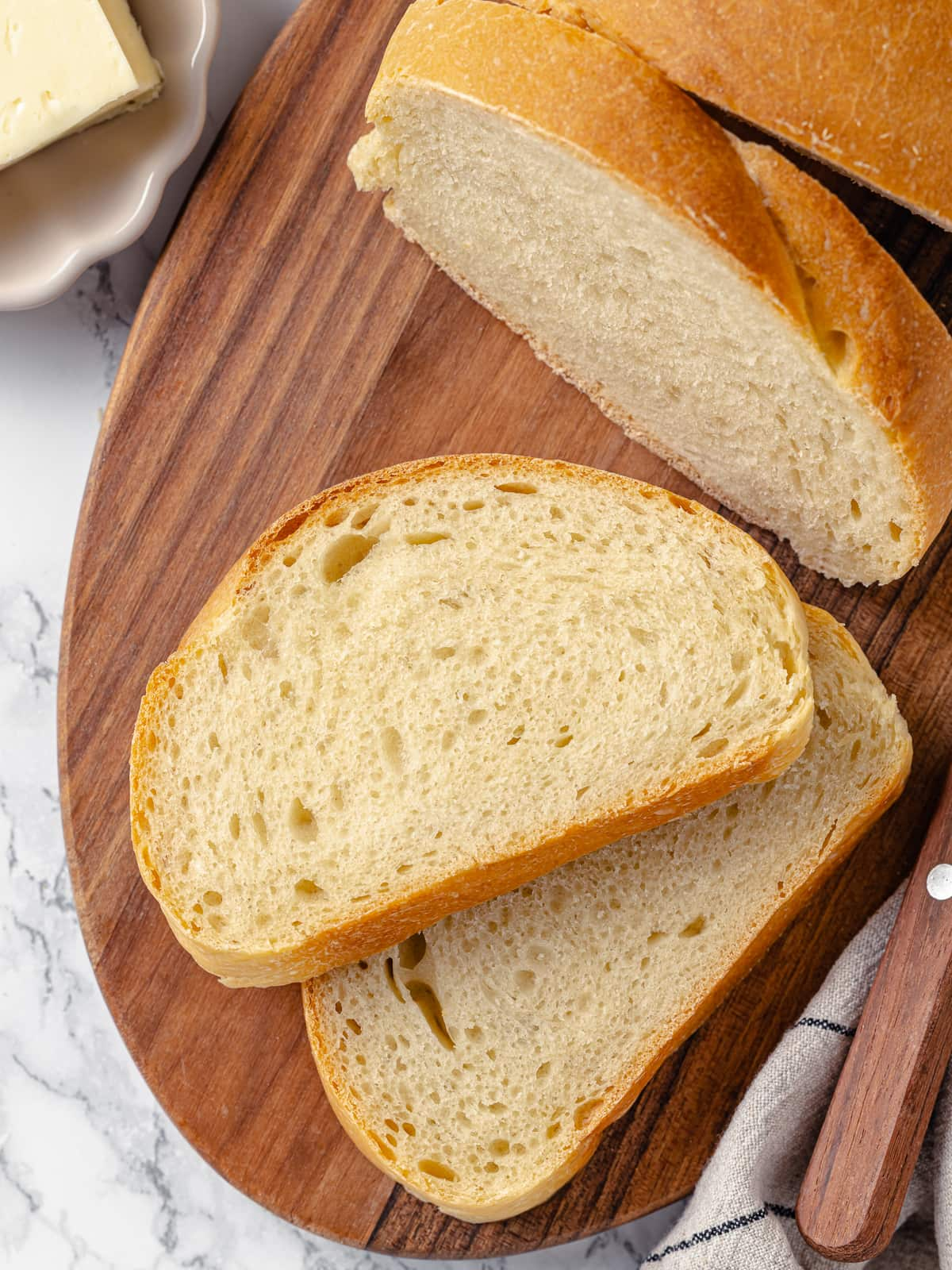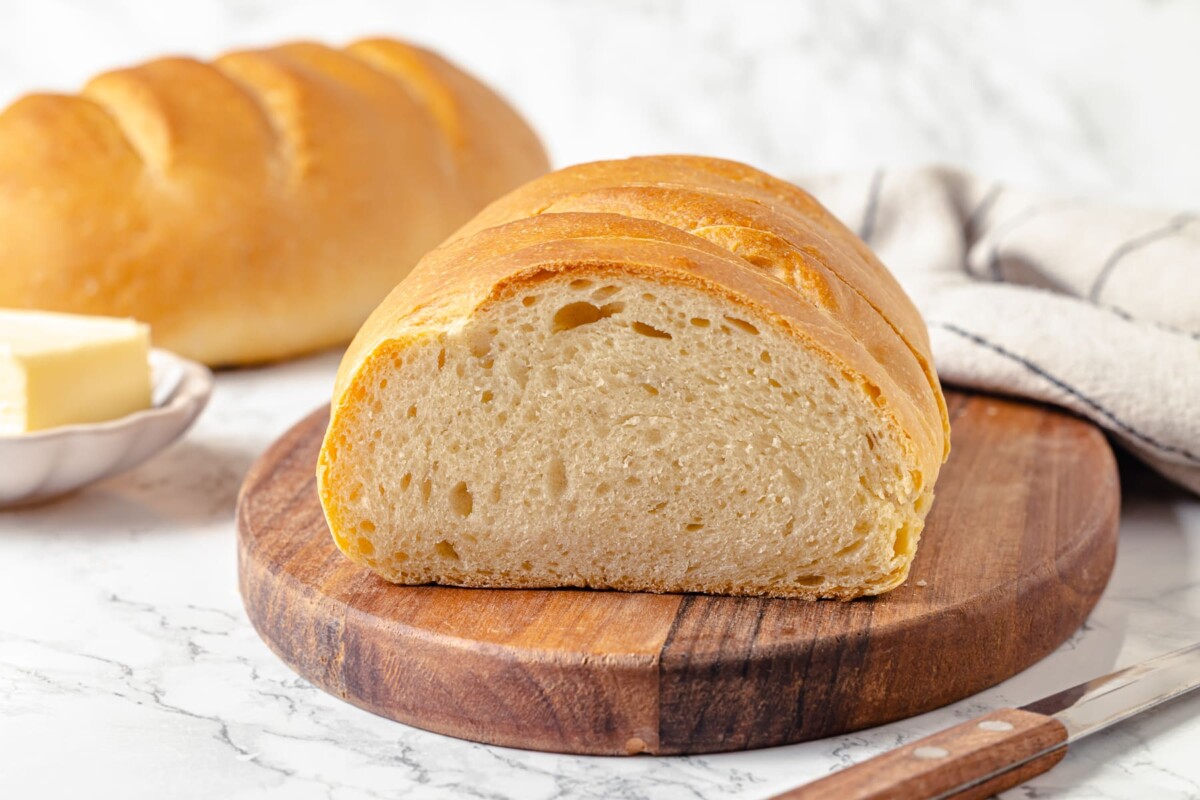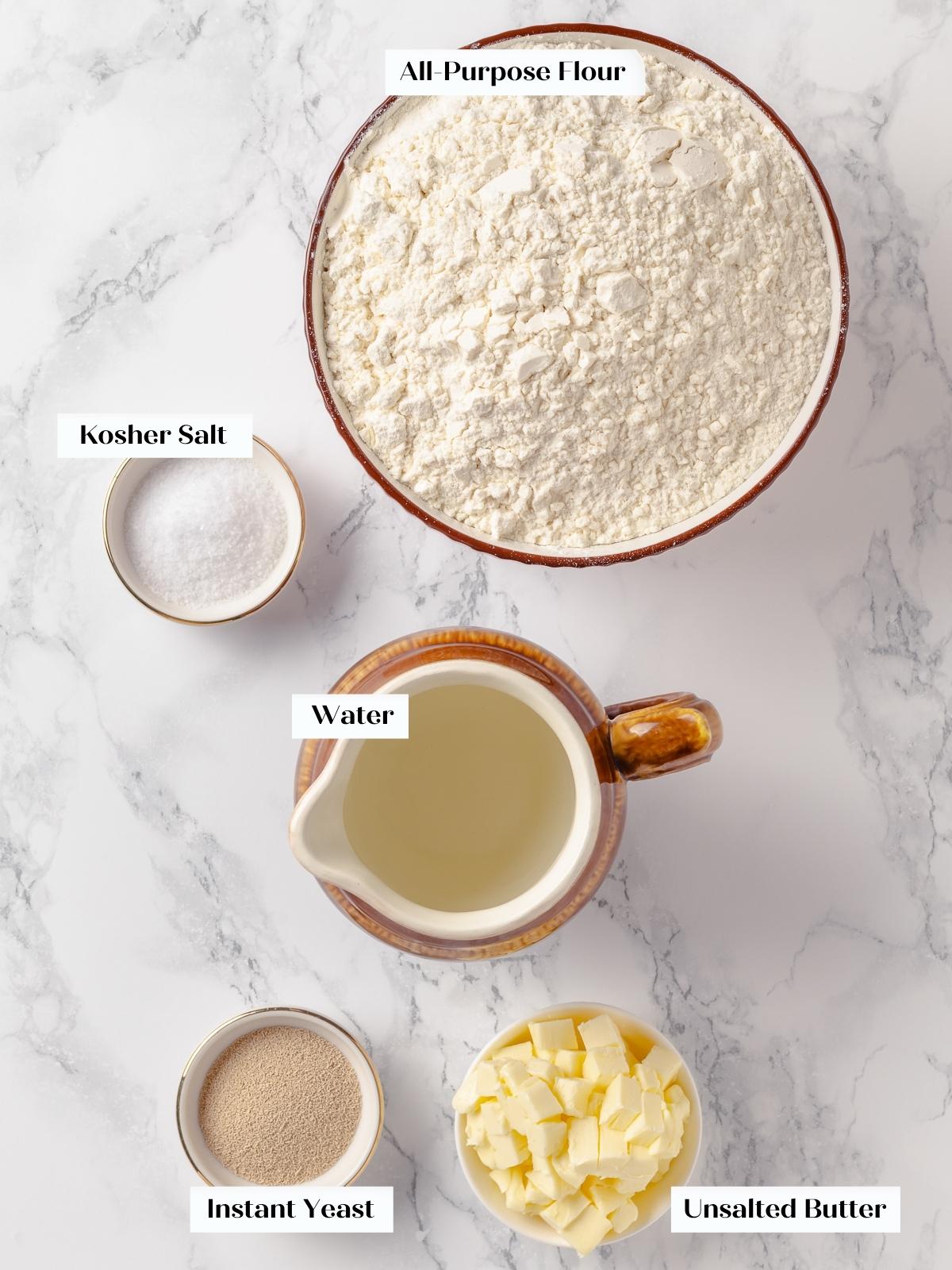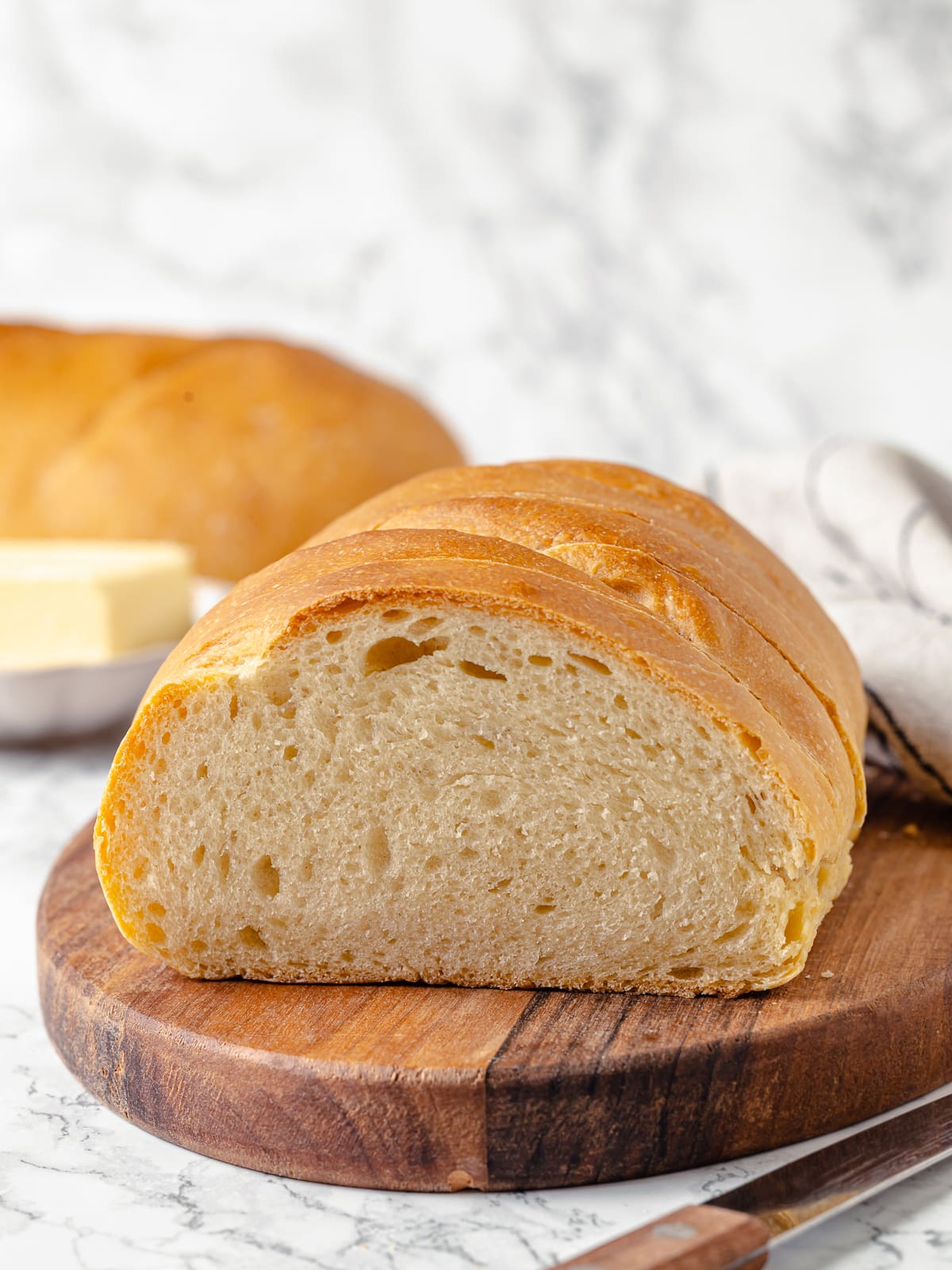
An easy recipe for soft French bread from scratch! You can have freshly baked bread that is better than store bought with 4 ingredients in under 2 hours!

I based this recipe on my sandwich bread recipe but omitted the sugar and used water in place of the milk. This gives you an easily sliceable, simple bread recipe that is perfect for family dinner or for company. Serve as an appetizer with a simple salad or a thick slice with easy Italian wedding soup.
This French bread is like those soft, store-bought loaves rather than a crusty baguette. Baguettes are unenriched breads, which means they only contain water, flour, salt and yeast. The little bit of butter in this recipe adds a softness to the crust and crumb.
Why This is the Best
- This bread bakes soft and fluffy with a tight crumb, just like store-bought but so much better.
- The crust initially has a slight crunch but softens as it cools due to the butter. This makes it very easy to slice for sandwiches or serving.
- Added softness and flavor with butter. Most recipes for French Bread Recipe use vegetable oil or olive oil. I assume this is based on the ingredients for a typical American loaf of “French Bread” but the French would have used butter, so that is what I use.
- Fast, flavorful recipe. Using instant rapid-rise yeast and blooming them in warm water, speeds up the proof time considerably. That means you can have bread in the oven in just over 90 minutes!
- Easy homemade bread recipe for beginners! The dough is easy to mix and very forgiving; the dough is soft, supple and not sticky; and it is incredibly easy to shape. This recipe stands alongside my sourdough bread recipe for beginners, no knead dutch oven bread and easy Italian bread recipe as the perfect entry into bread baking.

Ingredients & Substitutions

- Water: This recipe calls for water but you could also use milk like I do in my sandwich bread recipe..
- Instant Yeast: You could use the same amount of active dry yeast and follow the same recipe. Each proof will take longer and you’ll just need to adjust and follow the cues of the dough rather than the timeline in the recipe.
- All-Purpose Flour: I prefer all-purpose flour over bread flour in this recipe. Bread flour will also work but I recommend using 4 ¼ cups or the same gram measurement. You can also substitute up to half the amount of total flour with whole wheat flour to make whole wheat French bread!
- Kosher Salt: Salt is a key ingredient for flavor but also texture! It tenderizes and strengthens the gluten structure, which makes for a more tender, yet strong bread.
- Butter: I use unsalted butter in order to control the flavor of the bread. You can use cold or room temperature butter if mixing it in a stand mixer, but softened butter will be easier to incorporate by hand. You can also substitute vegetable oil, canola oil or olive oil if you prefer.
See the recipe card for full information on ingredients and quantities.
Variations
- Can I make this French bread into rolls? The short answer is you can absolutely shape and bake this dough into rolls or even 4 smaller loaves. This recipe will make about 20 rolls that weigh between 45-50 grams! You can shape, proof and bake them like the round variation of my parker house rolls recipe!
- Can I shape this dough into baguettes? You can absolutely shape this dough into 2 baguettes rather than bâtards. Pre-shape each piece of dough into a log, bench rest and then final shape into a log, rolling it out and slightly tapering at the ends. This is a similar process to shaping challah!
- Season the top! You can brush the dough with egg wash before scoring and baking, then sprinkle on sesame seeds, everything bagel seasoning or just leave it plain. After baking you can brush the loaves with melted butter and sprinkle with flaked sea salt. Both options will lead to a softer crust.
Pro Tips for Making the Best French Bread Recipe
- Bloom the instant yeast like you would dry active. Focused on flavor, texture, unique attributes or techniques that influence results.
- You could double the instant yeast for a faster rise, though I prefer the flavor and texture of just 1 packet. The 45 minutes that the dough bulk proofs allows the structure to strengthen, tighten and also relax before shaping. This also allows just enough time to develop natural flavor from the flour and yeast. Rushing it will lead to an overly yeasty, but otherwise bland, bread.
- I am shaping the loaf into a traditional bâtard, which is shaped like a log but it is tapered at each end and fatter in the middle. The best way to achieve this shape is to pre-shape into a boule (round), give it ample bench rest, then final shape it as you would a log but seal both ends and force the dough to be fatter in the center during the thumb folds.
How to Make this Homemade French Bread Recipe
Use these instructions to make super easy and delicious French bread for dinner tonight! Further details and measurements can be found in the recipe card below.
Step 1: Bloom the yeast. In a small bowl combine warm water and the instant yeast. Whisk or stir together with a fork, then let sit while you measure the remaining ingredients but no longer than 10 minutes.
Step 2: Mix the dough. In the bowl of a stand mixer fitted with the dough hook attachment, combine all-purpose flour, salt, and the yeast mixture. Mix on low speed until the dough is hydrated and all the ingredients have incorporated. It will only take a minute.
Step 3: Knead until elastic. Increase the mixer to medium speed for 4-5 minutes, or until a soft, strong, elastic dough forms that you can pull a rough window pane.
This isn’t the perfectly smooth window pane of a brioche dough, rather it is a clear window with some visible veining and striations.
Step 4: Add the butter. Add the pieces of butter to the mixer bowl and reduce the speed to low. Mix on low speed until all the butter has worked into the dough. If kneading by hand, I do recommend using room temperature butter but it isn’t essential and I used cold butter cut into tiny cubes when incorporating with my stand mixer.
It looks like a hot mess after adding it but it’ll incorporate. Once the butter works into the dough, the dough will look rough and under developed but it isn’t. Trust the process and the gluten you just developed.
Step 5: First proof. Use a bowl scraper or a stiff silicone spatula to scrape the dough out into a lightly oiled medium bowl, turn to coat. Cover with plastic wrap or a kitchen towel and proof at room temperature 45-60 minutes. The dough should have doubled.
Step 6: Divide dough. Turn the dough out onto a very lightly floured surface and divide into two equal pieces. They will each weigh about 485g if you choose to be precise.
Step 7: Preshape into rounds. Preshape one piece of dough into a round (boule) by flipping it over and folding each of the four sides towards the center. Flip back over (seam-side-down) and gently shape it into a round by pulling it towards you with both hands. Rotate a quarter turn and repeat until you have a round dough ball that sits up on your work surface. Repeat with the second piece of dough.
Try not to over tighten at this stage, shape just enough to form that tight ball then set aside. You’ll notice a visible difference in the dough after bulk proofing. It will no longer look rough but it will be smooth and elastic. That is the power of time and salt.
Step 8: Bench rest. Cover the dough with plastic wrap and allow to bench rest 15-20 minutes. This is longer than most bench rests because it needs that time to relax.
Step 9: Begin shaping. Flip the dough back over and take the side furthest from you, pick it up, give it a little shake to stretch slightly and then place it back on the bench folding the stretched side down to the center. Rotate the dough 180 degrees and repeat by folding the other side down towards the center.
I do not use any bench flour when working with this dough. I lightly oil my hands from the proof bowl and this dough does not stick. If you add more flour at this point not only will the dough be difficult to shape but the resulting bread will be dry.
Step 10: Final bâtard shaping. Shape a traditional bâtard by shaping as you would a log for sandwich bread or another bread baked in a loaf pan but tapering and sealing both ends so it is pointed at each end and fatter in the center. Perform 2 sets of thumb folds by wrapping the dough around the thumb of the left hand and sealing the edge with the heel of the right hand. Start this motion towards the right side (keeping it tighter at the end) and gradually move left, rolling and sealing as you go. The first thumb fold will not fully close the dough log. Perform 1 more thumb fold to fully create a tapered log shape.
Since we are not baking these loaves in loaf pans, I give them an extra serious pinch seal by basically smushing the seam into the bench with the heel of my hand. We want them to open at the top, not roll and open at the seam!
Step 11: Second proof. Line a sheet pan with a piece of parchment paper and place the shaped pieces of dough seam-side down on the diagonal at each end of the baking sheet. I used a flat (not rimmed) baking sheet to give myself a little more room for expansion. Cover loosely with plastic wrap (you can spray it with non-stick cooking spray as cheap insurance) and allow to proof in a warm spot for 30-45 minutes or until the dough has visibly doubled and is light and airy to the touch.
Step 12: Score the loaves. While the dough is final proofing, preheat the oven to 375°F conventional (no fan). Right before baking, gently remove the plastic wrap and score each loaf using a razor blade, bread lame, or very sharp knife. I score the dough similar to a baguette by making 3 slashes on the diagonal. The ends of each slash should overlap but be spaced about an inch apart.
Unlike sourdough bread or baguettes, I score this French bread dough perpendicularly to the top of the loaf and not on an angle. All of these steps together allow the dough to expand evenly. Try to get each cut as close to ½ inch deep as possible. Too shallow and the dough will have a difficult time expanding the way you want it to.
Step 13: Bake in a preheated oven for 28-30 minutes until the crust is a golden brown, or to an internal temperature of 205°F taken with an instant read thermometer.
Step 14: Cool before slicing. Remove the loaf from the oven and slide onto a wire rack to cool at least 15 minutes before slicing with a serrated knife.
Recipe FAQs
Store cooled French bread loaves in an airtight container, plastic wrap or a plastic baggie for up to a week at room temperature. It will remain perfectly soft for 3 days and then slowly begin to dry out. I do not recommend storing it in the refrigerator, as that will dry it out faster. For longer term storage, you can wrap the cooled loaves well and freeze for up to 3 months. I like to slice the loaves before freezing for easy toast, sandwiches or French toast!
As with all breads, it is best the day it is made, but it can be made a day in advance and warmed in a 350°F oven. To make further in advance, freeze the baked and cooled loaves as directed above. I am currently testing a partially baked version that you can keep in your freezer!
The butter in this bread recipe makes it naturally softer than a lean dough like this no knead sourdough bread or this peasant bread recipe. When baked as directed above, the crust will be initially crispy and then soften as it cools. To get a thicker crust that stays crispy longer, you’ll need to either bake them in a challenger pan or cast iron pan with a top like Dutch oven bread, or by making a steam oven out of your regular oven. You can do this by preheating a metal roasting pan in the bottom of the oven or on the lowest oven rack, then adding hot water to the pan right before baking, closing the oven door quickly to trap as much steam as possible. After 15 minutes open the door to release any remaining steam and allow a crust to form. You might consider baking it hotter, like at 425°F in addition to the steam or the Dutch oven.
The leftovers are the reason why I am always happy to make 2 loaves of this bread! It makes excellent sandwiches, toast, French toast, French toast casserole, French bread pizza, garlic bread, or this easy breakfast casserole with bread.

Recommended French Bread Recipes
If you enjoyed this recipe, please leave a star rating and let me know how it goes in the comments below! I love hearing from you and your comments make my day!
Prevent your screen from going dark
-
In a small bowl combine warm water and the instant yeast. Whisk or stir together with a fork, then let sit while you measure the remaining ingredients but no longer than 10 minutes.
-
In the bowl of a stand mixer fitted with the dough hook attachment, combine all-purpose flour, salt, and the yeast mixture. Mix on low speed until the dough is hydrated and all the ingredients have incorporated. It will only take a minute.
-
Increase the mixer to medium speed for 4-5 minutes, or until a soft, strong, elastic dough forms that you can pull a rough window pane. This isn’t the perfectly smooth window pane of a brioche dough, rather it is a clear window with some visible veining and striations.
-
Add the pieces of butter to the mixer bowl and reduce the speed to low. Mix on low speed until all the butter has worked into the dough. If kneading by hand, I do recommend using room temperature butter but it isn’t essential and I used cold butter cut into tiny cubes when incorporating with my stand mixer.
-
Use a bowl scraper or a stiff silicone spatula to scrape the dough out into a lightly oiled medium bowl, turn to coat. Cover with plastic wrap and proof at room temperature 45-60 minutes. The dough should have doubled.
-
Turn the dough out onto a very lightly dusted work surface and divide into two equal pieces. They will each weigh about 485g if you choose to be precise.
-
Preshape one piece of dough into a round (boule) by flipping it over and folding each of the four sides towards the center. Flip back over (seam-side-down) and gently shape it into a round by pulling it towards you with both hands. Rotate a quarter turn and repeat until you have a round dough ball that sits up on your work surface. Try not to over tighten at this stage, shape just enough to form that tight ball then set aside. Repeat with the second piece of dough.
-
Cover the dough with plastic wrap and allow to bench rest 15-20 minutes. This is longer than most bench rests because it needs that time to relax.
-
Flip the dough back over and take the side furthest from you, pick it up, give it a little shake to stretch slightly and then place it back on the bench folding the stretched side down to the center. Rotate the dough 180 degrees and repeat by folding the other side down towards the center.
-
Shape a traditional bâtard by shaping as you would a log for sandwich bread or another bread baked in a loaf pan but tapering and sealing both ends so it is pointed at each end and fatter in the center. Perform 2 sets of thumb folds by wrapping the dough around the thumb of the left hand and sealing the edge with the heel of the right hand. Start this motion towards the right side (keeping it tighter at the end) and gradually move left, rolling and sealing as you go. The first thumb fold will not fully close the dough log. Perform 1 more thumb fold to fully create a tapered log shape.
-
Line a sheet pan with a piece of parchment paper and place the shaped pieces of dough seam-side down on the diagonal at each end of the baking sheet. I used a flat (not rimmed) baking sheet to give myself a little more room for expansion. Cover loosely with plastic wrap (you can spray it with non-stick cooking spray as cheap insurance) and allow to proof in a warm spot for 30-45 minutes or until the dough has visibly doubled and is light and airy to the touch.
-
While the dough is final proofing, preheat the oven to 375°F conventional (no fan).
-
Right before baking, gently remove the plastic wrap and score each loaf using a razor blade, bread lame, or very sharp knife. I score the dough similar to a baguette by making 3 slashes on the diagonal. The ends of each slash should overlap but be spaced about an inch apart. Unlike sourdough bread or baguettes, I score this French bread perpendicularly to the dough and not on an angle. All of these steps together allow the dough to expand evenly. Try to get each cut as close to ½ inch deep as possible. Too shallow and the dough will have a difficult time expanding the way you want it to.
-
Bake in a preheated oven for 28-30 minutes to an internal temperature of 205°F. Remove the loaf from the oven and slide onto a wire rack to cool at least 15 minutes before slicing with a serrated knife.
Yield – 2 loaves
Technique – I give them an extra serious pinch seal.
Variations – Make rolls or baguettes. Top with seeds or butter and sea salt.
Storage – Keep in airtight container up to a week. Freeze sliced for toast or sandwiches.
Serving: 1slice, Calories: 106kcal, Carbohydrates: 18g, Protein: 3g, Fat: 2g, Saturated Fat: 1g, Polyunsaturated Fat: 0.2g, Monounsaturated Fat: 1g, Trans Fat: 0.1g, Cholesterol: 5mg, Sodium: 244mg, Potassium: 38mg, Fiber: 1g, Sugar: 0.1g, Vitamin A: 59IU, Vitamin C: 0.004mg, Calcium: 5mg, Iron: 1mg
Nutrition information is automatically calculated, so should only be used as an approximation.
 Like this recipe? Rate & comment below!
Like this recipe? Rate & comment below!Before You Go
I hope you enjoyed this professional chef created recipe. Check out our other delicious, yeasted bread recipes!











